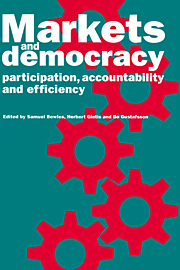Book contents
- Frontmatter
- Contents
- List of figures
- List of tables
- Preface
- 1 Post-Walrasian political economy
- Part I Agency, incentives, and democratic accountability
- Part II Institutions and institutional change
- Part III Conditions for the success of the democratic firm
- Part IV Productivity, distribution, and power
- 12 Cooperation, conflict, and control in organizations
- 13 Wage bargaining and the choice of production technique in capitalist firms
- Part V Ownership, participation and capital markets
- Part VI Political democracy and economic democracy
- Bibliography
- Author index
- Subject index
12 - Cooperation, conflict, and control in organizations
Published online by Cambridge University Press: 05 March 2012
- Frontmatter
- Contents
- List of figures
- List of tables
- Preface
- 1 Post-Walrasian political economy
- Part I Agency, incentives, and democratic accountability
- Part II Institutions and institutional change
- Part III Conditions for the success of the democratic firm
- Part IV Productivity, distribution, and power
- 12 Cooperation, conflict, and control in organizations
- 13 Wage bargaining and the choice of production technique in capitalist firms
- Part V Ownership, participation and capital markets
- Part VI Political democracy and economic democracy
- Bibliography
- Author index
- Subject index
Summary
Introduction
A multitude of individuals and entities (“participants”) have a stake in any organization. Resource suppliers, for example, have an interest in how an organization functions because their own well-being is affected via their remuneration. Likewise, the welfare of the users of an organization‘s output is affected by price, quality and other decisions made in the organization. The interests of various participants with a stake in the same organization are both intertwined and divergent. Participants seek both to maximize the total return from their common transactions (i.e., the size of the surplus that can be distributed among them) and to maximize their respective shares in the surplus. The desire to maximize total surplus amounts to maximizing productivity and technical efficiency and minimizing production and transactions costs; this draws participants together and drives them to cooperate. The goal of maximizing individual shares propels participants to conflict with each other (either individually or in groups), possibly to the detriment of the size of the total surplus.
Incentives for both cooperation and conflict exist because participants must often bear some costs in moving from one organization to another and because participants who have already collaborated together, having developed relationship-specific human and physical capital, are capable of generating more value than other combinations of participants (Aoki, 1984; FitzRoy and Mueller, 1984).
Cooperation and conflict characterize all organizations. Likewise, control is employed universally. Different organizational structures, production technologies and environments are associated with different degrees of cooperation and conflict and with different methods of control.
- Type
- Chapter
- Information
- Markets and DemocracyParticipation, Accountability and Efficiency, pp. 199 - 216Publisher: Cambridge University PressPrint publication year: 1993
- 4
- Cited by



